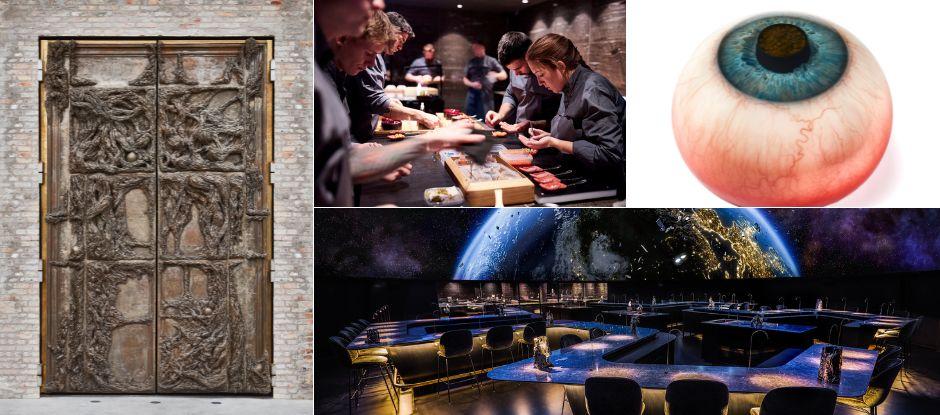Alchemist, which has just bagged the Gin Mare Art of Hospitality Award 2023, considers every element that influences its guests’ enjoyment and understanding, from the smallest detail to its larger-than-life audio-visuals. Here, the Copenhagen restaurant’s leading actors offer a glimpse behind the scenes and just a taste of what prospective diners might expect
After driving to the northern end of Refshaleøen, a dockland area jutting out into the sea from Copenhagen, guests are deposited outside a giant warehouse. Set into the bare industrial exterior is a pair of enormous, embossed bronze doors – a piece entitled ‘I found myself within a forest dark’ created by Danish artist Maria Rubinke.
There is no restaurant sign, no indication of what lies inside. But this is the beginning of the extraordinary, multi-sensory, socially conscious, conceptual experience that is dining at Alchemist, newly crowned winner of the Gin Mare Art of Hospitality Award at The World’s 50 Best Restaurants 2023, sponsored by S.Pellegrino & Acqua Panna.
The doors slowly open and the willing gastro guinea pigs are greeted warmly by the front of house team. From this initial conversation, along with information gleaned during the reservation process, the careful but dynamic tailoring of each party’s experience begins.
Between four and six hours later, diners emerge – usually forever changed in some way, not least because they will have banked a lifetime memory. So how does Alchemist curate such a stimulating and sometimes deliberately challenging culinary encounter, one that is perhaps the most deeply intentional in the restaurant world?
In conversation with chef Rasmus Munk and general manager Lykke Metzger, we identify seven secrets behind the restaurant’s unparalleled level of service.
1. Dynamic tailoring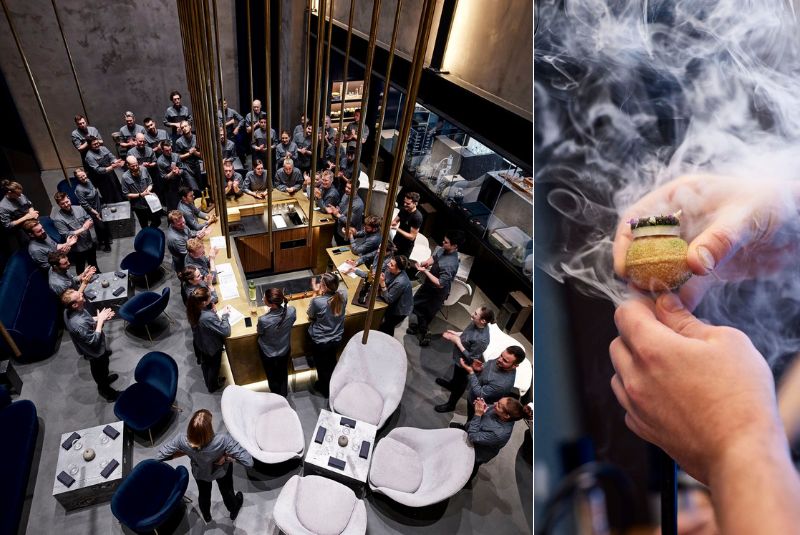
Team briefing – the beginning of an ever-evolving service plan; the Smokey Ball snack
We’re not talking about sharply cut staff uniforms (more of which later), but the highly flexible service style which sees the hospitality team fine tune each group’s experience through the evening.
It kicks off with the aforementioned greeters at the door, who will engage in a few minutes’ conversation with the expectant guests and then pass on information to the team inside. This might include nationality, language and the nature of the group, plus extra notes on where else they might have dined, when they arrived in the city, and even the colour of their eyes (to match one of the dishes with their eye colour, no less).
From this, Metzger adapts the service plan accordingly, assigning whomever from her diverse team she believes is most appropriate to act as the ‘lead’ server for the group. “I always tell the team that, whatever we have planned at our briefing at 2pm, the service itself can bring something unexpected,” says the quietly confident Metzger. “I have never worked at a restaurant with so many different types of guests coming – journalists, foodies, groups of friends, chefs, maybe an older local couple or couples who have saved up a whole year to come and dine with us.”
After an initial immersive and theatrical opening, guests come through to the lounge space with a view into the test kitchen and beneath an imposing wine tower. Here they are served a series of snacks and start interacting further with their primary host, who is there to guide and, if necessary, reassure.
“We want to create a bond from the beginning,” says Metzger. “Because when they come in, a lot of guests have no idea what to expect. Sometimes we need to hold their hands to guide them through the experience.”
The team also observes how the guests are behaving as the evening unfolds. “Maybe they are louder than some others, so we place them in a different position within the dome [main dining space]. Perhaps we realise this pair would really appreciate seeing into the kitchen. Others may be particularly interested in wine or our non-alcoholic drinks, so we might subtly shift who serves them at certain points,” she says.
2. Invisible hospitality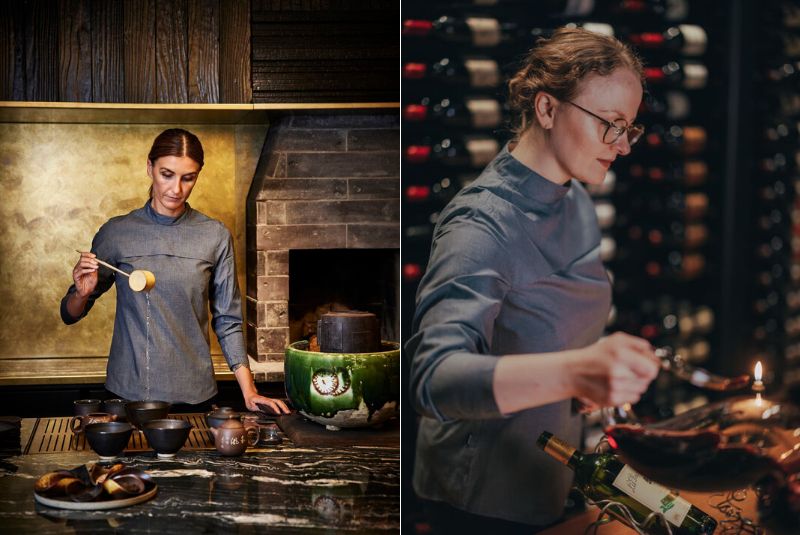
General manager Lykke Metzger (left) and wine director Nina Højgaard Jensen – architects of ‘invisible hospitality’
After a settling-in period in the lounge, guests are ushered into the main dining area, where they are seated at a zig-zagging counter beneath an enormous dome, which features high-definition video-scapes. It is here that the majority of courses are served, whether by the front-of-house team or the chefs. Indeed, all staff are dressed in the same uniform – the only difference being that the kitchen team are also in aprons.
It’s all part of Alchemist’s philosophy of ‘invisible hospitality’, which refers to the fact that there is no discernible hierarchy in the service team from the guests’ perspective. “No matter who comes to the table, [the guests] will always feel that they are treated equally. That also means they treat the staff equally and that helps our team really bloom,” says Metzger.
This approach manifests itself in anyone being able to serve the wine or discuss a dish, but therefore only works if the entire team has that all-round knowledge. Conversely, it also means that team members can switch in and out of certain roles at any given time, increasing the flexibility to enable further bespoke adjustments.
“If our wine director, Nina [Højgaard Jensen], is wearing a sommelier jacket and is serving a group for much of the evening, then the group next door is wondering why they are not getting the same and instead they ‘just’ have a waiter,” explains Metzger. “We don’t want them to have that feeling.”
“But if a group has an incredible knowledge of wine, then of course it’s better that we switch a sommelier to that table. The same if they are talking about coffee or tea, we have staff who have really dug deep into that. We are always asking ourselves, ‘how can we lift the experience for the guests?’”
The uniformity extends to none of the team wearing any watches or rings that might distract from the delivery of the dishes themselves. What’s more, once guests are transported to the balcony area at the end of the meal, staff there will be dressed differently again – this time in order to blend into the background “like shadows”. The thinking is that, by this stage, the guests have already received so much food, drink and information that they need to relax and digest it all.
3. Don’t forget the food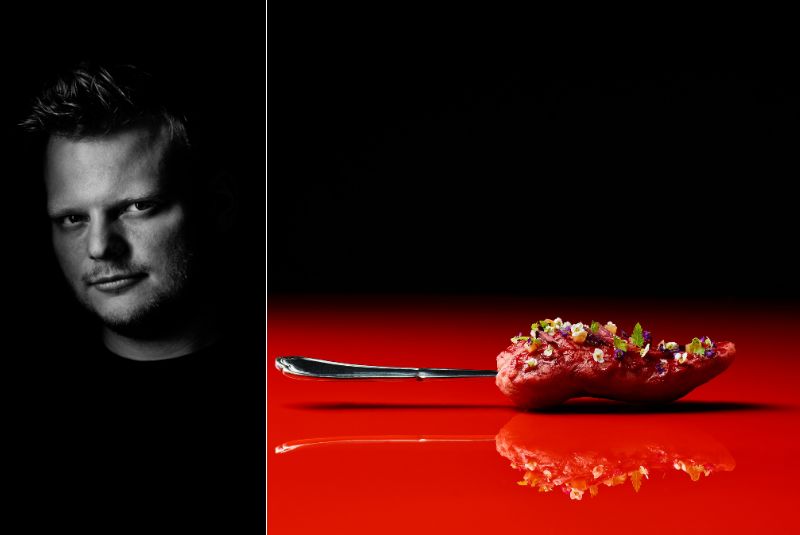
Chef Rasmus Munk; Tongue Kiss
It’s easy to imagine that the dishes themselves at Alchemist might become secondary to their delivery, overshadowed by the different spaces, multi-sensory stimulation and accompanying social messaging. As the chef and chief creative force behind the entire Alchemist project, Rasmus Munk has other ideas, however.
“All of our dishes are developed in a very neutral kitchen – we actually never do a tasting in the dome, for example,” says Munk. “Only when the food is done do we look at the composition of the lights and the kind of design material that we might use for the plates and so on.”
Texture and taste remain sacrosanct for the culinary team: the dish has to work on its own first, then it is enhanced as much as possible by the accompanying elements, from the music to how it is served and described.
“Food comes first and we will never compromise that. The dish might be challenging, but it still needs to taste good!” he adds. The team aims to introduce two new dishes to the menu each month, some of which are entirely original, while others are seasonal updates on existing themes.
Inspiration comes from anywhere: Munk and Metzger – partners in life as well as work – travel internationally when they can and return full of fresh ideas; other artistic fields are also a source of creativity, as is technology, nature and the multi-national Alchemist team itself.
4. Ambassadors of activism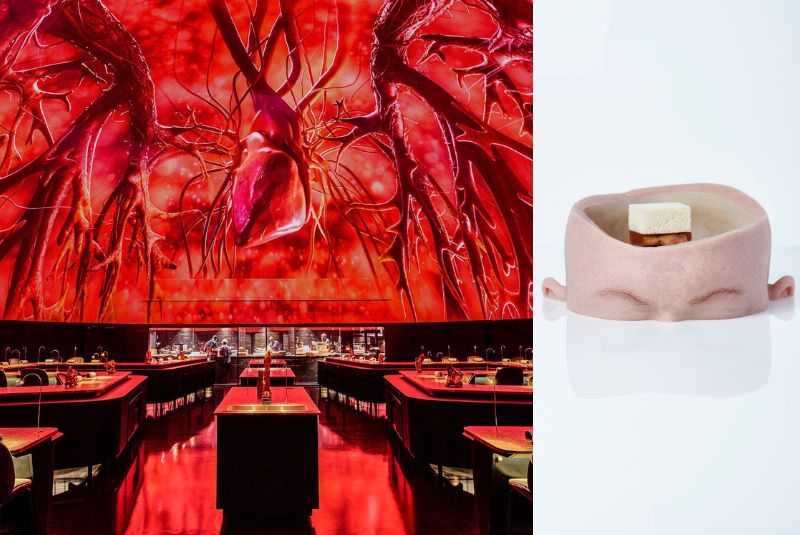
The dome above the dining space reinforces the messaging; Food for Thought
A distinctive component of the Alchemist experience is the way it presents an unashamed social conscience, seeking to highlight problematic issues through food. Dishes reference subjects as varied as child labour, microplastics in the ocean, battery farming, state surveillance and homelessness.
Munk describes the service team as “our ambassadors for activism. They transact a lot of the emotions we try to invoke.” The restaurant employs an in-house script writer and staff work off a 100-page document detailing not just every element of each dish and drink, but exploring the research and statistics behind the different themes, as well as information on the overall production.
It means there is always a balance to find between being perceived as ‘preachy’ and conveying such important messages, but it is one that the Alchemist crew strike with characteristic intuition: they engage more deeply where prompted, but hold back if they think the narrative is getting in the way of the guests’ enjoyment or prompting overwhelming emotion.
“We have learnt to read people’s reactions and emotions – and how much they can handle. We have to remind ourselves that the guests are not there for our expertise, but that we are here for them,” says Metzger.
Some of the more extreme dishes, or ‘impressions’, include: Food for Thought – steamed lamb’s brain served on brioche and presented inside a model of a human head, designed to prompt discussion on food waste and differing perceptions of what is edible; and Lifeline – an ice cream dessert made with pig’s blood, cast in the shape of a droplet of blood, that aims to encourage people to donate blood themselves.
“There are some things we serve which really need an explanation,” adds Munk, with a degree of understatement.
5. Casting agents
Uniforms are uniform at Alchemist, and it’s a truly immersive experience
Metzger’s service team numbers around 25 people and encompasses at least a dozen different nationalities. Finding the right blend is a jigsaw puzzle that has to consider language skills and different personality types.
“At Alchemist, I’ve actually hired five people [since it opened] that had no previous waiter experience at all, but I could see they had an amazing personality that would be a good match for the restaurant,” she says. All staff undergo an initial intensive eight-week training programme across all facets, but the learning continues for months, if not years.
Metzger also wants a diverse mix of extroverts and what she calls “information nerds”, as well as a range of French, Spanish, Italian and, ideally, Chinese speakers. With only four services per week (dinner Tuesday to Friday), it means all hospitality staff can work the same shifts, enhancing their learning and inter-changeability, depending on their individual situations.
“Staff can be very tired at the end of the week because they have given so much of themselves; there are so many debates and conversations that can be raised,” says Munk. “But a lot of people say that they can feel the staff are happy to be here. The next generation don’t just want to serve a plate of food, they are actually proud to convey important messages.”
6. Psychology, body language, voice coaching and more
Many of Munk’s dishes challenge preconceptions; the menu – artists and designers are part of the team
Unlike a conventional restaurant, Alchemist employs a range of experts in different fields of production, from visual effects artists and sound engineers to animators, industrial designers, composers and writers. Guests may even encounter actors and dancers as part of their evening’s interactive and immersive entertainment.
The next frontier for Munk and Metzger is around voice coaching, body language and psychology. They have been working with a voice coach to learn about projection, adjusting tone and volume to create different effects and other dramatic skills.
The body language factor translates not only into the choreography of movement through the dining space, but exactly how individual dishes might be delivered. For example, for Hunger, a dish that tackles the issue of global food insecurity, the wait staff present the dish openly to the diner as if sharing.
“We all know that body language is hugely important [in how someone receives and perceives information], but it has not really been focused on in the restaurant industry. It’s interesting to use different artistic fields and skills and apply them to the culinary world,” says Munk.
The combination of attention to the sort of detail one might never notice, alongside a holistic vision for inter-disciplinary development, is central to what sets Alchemist apart. And there’s more to come: Munk is looking into how psychologists can bring a new dimension to the art (and science) of hospitality.
“The last year we have worked a lot around design and architecture. Before that we were looking more at art and theatre. In the next period we will look more at psychology and how that can be translated into the experience,” he says.
7. Open-source philosophy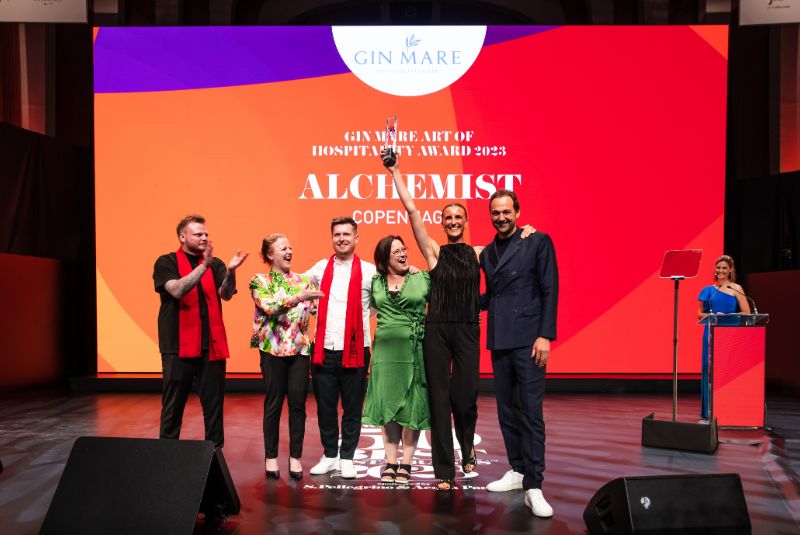
Metzger holds the Gin Mare Art of Hospitality Award aloft on stage in Valencia
The Alchemist team recognises it is in a hugely privileged position, as it is backed by philanthropic investors in Lars and Yvonne Seier Christensen. But Munk believes its success is not down to money alone, but because they focus on every element of the guest experience. He is also keen to share the team’s learnings as widely as possible.
“We have gained a lot of knowledge and we are quite ‘open source’ with that in articles, scientific papers and even social media posts. There will also be books and catalogues to come.
“I hope we can inspire people to think more broadly: instead of hiring another chef to place the herbs perfectly on top a dish, maybe employ an industrial designer instead to look at the table and seating, because this is an area that means something to the guest – they don’t care about the herbs.”
Metzger recalls being presented with the Gin Mare Art of Hospitality Award at The World’s 50 Best Restaurants gala in Valencia in June. “It was the proudest moment in my whole career in this industry. We’ve been open four years… looking out at all the other restaurants where we have spent so much of our time and money to go and learn from, it was very emotional.
“When we got back to the restaurant, Rasmus made a really beautiful speech before service remembering that we did it all together as a team – including not only the chefs, because they are always part of the service, but everybody at Alchemist. Everyone helps make it a great experience, and every day we will try to make it even better.
“I said to the team: ‘We have this award now: care for it and respect it. Unite together to live up to it,’” Metzger concludes.
On the evidence to date, the Alchemist team will embrace that challenge.
The list of The World's 50 Best Restaurants 2023, sponsored by S.Pellegrino & Acqua Panna, was announced on Tuesday 20th June at a live awards ceremony in Valencia. To stay up to date with the latest news, follow us on Instagram, Facebook, Twitter and YouTube, and sign up to our newsletter.
